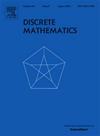Shortness parameters of polyhedral graphs with few distinct vertex degrees
IF 0.7
3区 数学
Q2 MATHEMATICS
引用次数: 0
Abstract
We devise several new upper bounds for shortness parameters of regular polyhedra and of the polyhedra that have two vertex degrees, and relate these to each other. Grünbaum and Walther showed that quartic polyhedra have shortness exponent at most . This was subsequently improved by Harant to , which holds even when all faces are either triangles or of length k, for infinitely many k. We complement Harant's result by strengthening the Grünbaum-Walther bound to , and showing that this bound even holds for the family of quartic polyhedra with faces of length at most 7. Furthermore, we prove that for every the shortness exponent of the polyhedra having only vertices of degree 3 or ℓ is at most . Motivated by work of Ewald, we show that polyhedral quadrangulations with maximum degree at most 5 have shortness coefficient at most 30/37. Finally, we define path analogues for shortness parameters, and propose first dependencies between these measures.
具有几个不同顶点度的多面体图的短参数
我们设计了正多面体和有两个顶点度的多面体的短度参数的上界,并将它们相互联系起来。gr nbaum和Walther证明了四次多面体的短指数不超过log (22) /log(23)。随后,Harant将其改进为log (16) /log(17),即使当所有面都是三角形或长度为k时,对于无穷多个k,它也成立。我们通过将gr nbaum- walther界强化为log (4) /log(5)来补充Harant的结果,并表明该界甚至适用于面长度最多为7的四次多面体族。进一步证明了对于每一个4≤r≤r的多面体,其顶点为3度或r的多面体的最短指数不超过log (5) /log(7)。在Ewald工作的激励下,我们证明了最大度不超过5的多面体四边形的短系数不超过30/37。最后,我们定义了短度参数的路径类似物,并提出了这些度量之间的第一依赖关系。
本文章由计算机程序翻译,如有差异,请以英文原文为准。
求助全文
约1分钟内获得全文
求助全文
来源期刊

Discrete Mathematics
数学-数学
CiteScore
1.50
自引率
12.50%
发文量
424
审稿时长
6 months
期刊介绍:
Discrete Mathematics provides a common forum for significant research in many areas of discrete mathematics and combinatorics. Among the fields covered by Discrete Mathematics are graph and hypergraph theory, enumeration, coding theory, block designs, the combinatorics of partially ordered sets, extremal set theory, matroid theory, algebraic combinatorics, discrete geometry, matrices, and discrete probability theory.
Items in the journal include research articles (Contributions or Notes, depending on length) and survey/expository articles (Perspectives). Efforts are made to process the submission of Notes (short articles) quickly. The Perspectives section features expository articles accessible to a broad audience that cast new light or present unifying points of view on well-known or insufficiently-known topics.
 求助内容:
求助内容: 应助结果提醒方式:
应助结果提醒方式:


